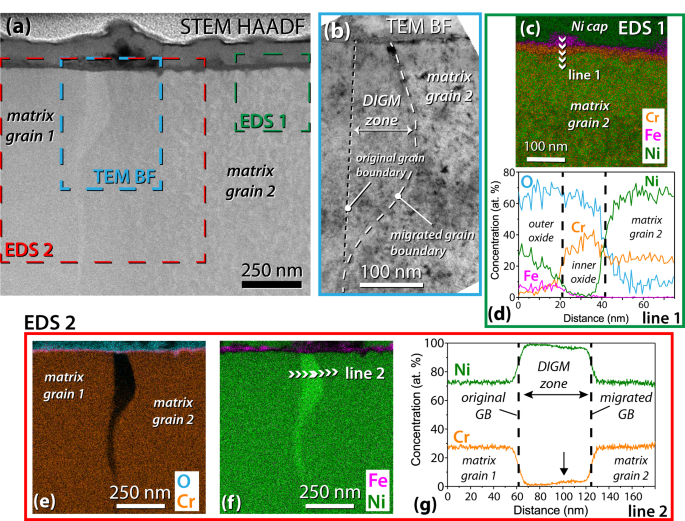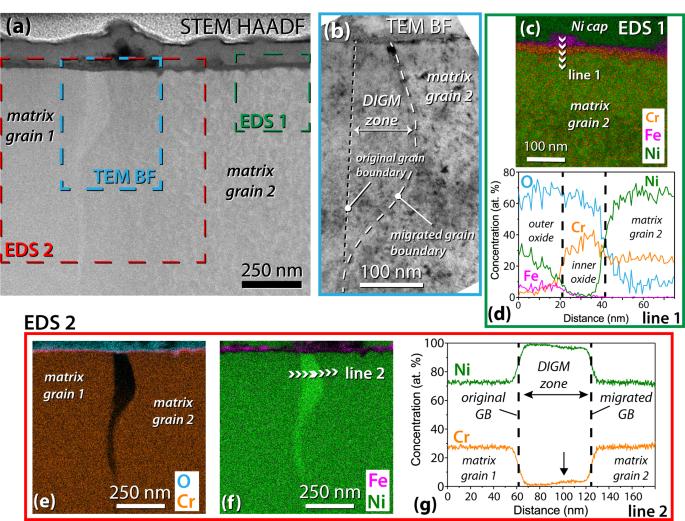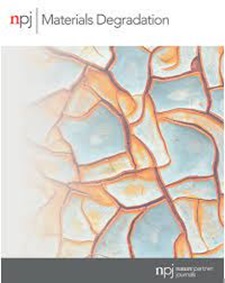Intergranular corrosion of Ni-30Cr in high-temperature hydrogenated water after removing surface passivating film
IF 7.6
2区 材料科学
Q1 MATERIALS SCIENCE, MULTIDISCIPLINARY
引用次数: 0
Abstract
High-resolution transmission electron microscopy and atom probe tomography are used to characterize the initial passivation and subsequent intergranular corrosion of degraded grain boundaries in a model Ni-30Cr alloy exposed to 360 °C hydrogenated water. Upon initial exposure for 1000 h, the alloy surface directly above the grain boundary forms a thin passivating film of Cr2O3, protecting the underlying grain boundary from intergranular corrosion. However, the metal grain boundary experiences severe Cr depletion and grain boundary migration during this initial exposure. To understand how Cr depletion affects further corrosion, the local protective film was sputtered away using a glancing angle focused ion beam. Upon further exposure, the surface fails to repassivate, and intergranular corrosion is observed through the Cr-depleted region. Through this combination of high-resolution microscopy and localized passive film removal, we show that, although high-Cr alloys are resistant to intergranular attack and stress corrosion cracking, degradation-induced changes in the underlying metal at grain boundaries make the material more susceptible once the initial passive film is breached.


去除表面钝化膜后高温氢化水中 Ni-30Cr 的晶间腐蚀
利用高分辨率透射电子显微镜和原子探针层析成像技术对暴露在 360 °C 加氢水中的模型镍-30Cr 合金中退化晶界的初始钝化和随后的晶间腐蚀进行了表征。初始暴露 1000 小时后,晶界正上方的合金表面形成一层薄薄的 Cr2O3 钝化膜,保护下层晶界免受晶间腐蚀。然而,在初始暴露期间,金属晶界经历了严重的铬耗竭和晶界迁移。为了解铬耗竭对进一步腐蚀的影响,使用闪烁角聚焦离子束溅射掉了局部保护膜。进一步暴露后,表面无法再钝化,通过铬贫化区域观察到晶间腐蚀。通过这种高分辨率显微镜和局部被动膜去除相结合的方法,我们表明,虽然高铬合金具有抗晶间腐蚀和应力腐蚀开裂的能力,但一旦最初的被动膜被破坏,晶界处底层金属的降解诱导变化会使材料更容易受到影响。
本文章由计算机程序翻译,如有差异,请以英文原文为准。
求助全文
约1分钟内获得全文
求助全文
来源期刊

npj Materials Degradation
MATERIALS SCIENCE, MULTIDISCIPLINARY-
CiteScore
7.80
自引率
7.80%
发文量
86
审稿时长
6 weeks
期刊介绍:
npj Materials Degradation considers basic and applied research that explores all aspects of the degradation of metallic and non-metallic materials. The journal broadly defines ‘materials degradation’ as a reduction in the ability of a material to perform its task in-service as a result of environmental exposure.
The journal covers a broad range of topics including but not limited to:
-Degradation of metals, glasses, minerals, polymers, ceramics, cements and composites in natural and engineered environments, as a result of various stimuli
-Computational and experimental studies of degradation mechanisms and kinetics
-Characterization of degradation by traditional and emerging techniques
-New approaches and technologies for enhancing resistance to degradation
-Inspection and monitoring techniques for materials in-service, such as sensing technologies
 求助内容:
求助内容: 应助结果提醒方式:
应助结果提醒方式:


